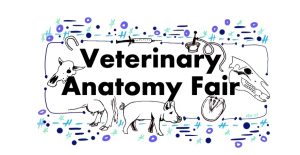
Assessments in the Anatomy of the Large Domestic Animals (ALDA) course were transformed, aiming to provide students with a more authentic way to engage with the content, foster agency, increase relevance, and improve long term retention of key concepts by shifting students’ cognitive focus higher up Bloom’s taxonomy pyramid to apply, evaluate and create. This assessment is designed to promote the formation of professional skills and identities through direct interactions with the veterinary community, as well as providing opportunities to incorporate relevant clinical skills.
The ALDA teaching team leads a comparative anatomy course that follows the small animal anatomy course. At the end of each unit, a traditional low-stakes anatomy assessment (pin test, MC, binary, and multiple drop downs) occurs, followed by student presentations at an open house, called a Veterinary Anatomy Fair. Students choose a topic from the unit and create an individualized project to present. The fair is open to all members of the School of Veterinary Medicine (SVM) community, providing a varied audience, ranging from staff to peers and veterinarians. Students are encouraged to adapt their language to best serve the experience level of their audience, simulating the diversity of individuals they will encounter as clinicians – clients, peers, and specialists. Audience members are encouraged to provide constructive feedback to presenters via a rubric, enabling reflection and modification prior to the students final online submission.
Our findings support that student engagement with content at lower levels of Bloom’s taxonomy is best reinforced with pin and MC/binary assessments. The authors’ anecdotal data shows that the presentation type assessments foster engagement at higher levels of Bloom’s taxonomy, through the building of individual projects, repeated explanations and audience interactions. Through these presentations, students become content experts, perform relevant research, work towards professional goals and are highly motivated to perform well around their peers. From an educational perspective, incorporation of this assessment has paired learning anatomical concepts with acquisition of professional identities and professional and clinical skills. From a learner’s perspective, the structure of the assessment additionally cultivates agency, confidence and motivation while meeting course outcomes.
"Anything you don’t know is going to be hard at first, but if you stay the course, put the time and effort in, it will become seamless eventually."
-Jeanette Epps (inventor, aerospace engineer, astronaut)









